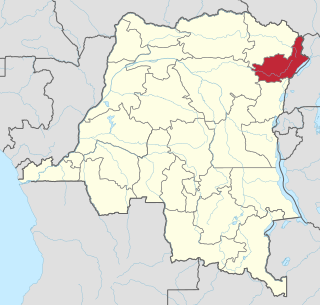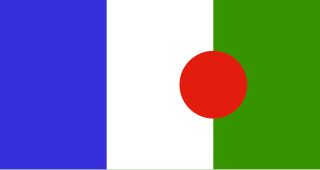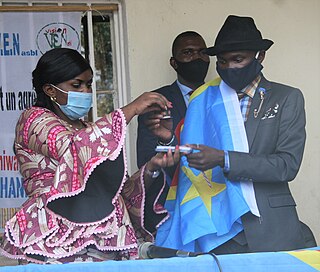Related Research Articles
The Hutu, also known as the Abahutu, are a Bantu ethnic or social group which is native to the African Great Lakes region. They mainly live in Rwanda, Burundi and the eastern Democratic Republic of the Congo, where they form one of the principal ethnic groups alongside the Tutsi and the Great Lakes Twa.
The Tutsi, also called Watusi, Watutsi or Abatutsi, are an ethnic group of the African Great Lakes region. They are a Bantu-speaking ethnic group and the second largest of three main ethnic groups in Rwanda and Burundi.

East Africa, also known as Eastern Africa or the East of Africa, is a region at the eastern edge of the African continent, distinguished by its geographical, historical, and cultural landscape. Defined in varying scopes, the region is recognized in the United Nations Statistics Division scheme as encompassing 18 sovereign states and 4 territories.
The early history of Uganda comprises the history of Uganda before the territory that is today Uganda was made into a British protectorate at the end of the 19th century. Prior to this, the region was divided between several closely related kingdoms.

Ankole was a traditional Bantu kingdom in Uganda and lasted from the 15th century until 1967. The kingdom was located in south-western Uganda, east of Lake Edward.
Banyamulenge is a community from the Democratic Republic of the Congo's South Kivu province. The Banyamulenge are culturally and socially distinct from the Tutsi of North Kivu, with most speaking Kinyamulenge, a mix of Kinyarwanda, Kirundi, Ha language, and Swahili. Banyamulenge are often discriminated against in the DRC due to their Tutsi phenotype, similar to that of people living in the Horn of Africa, their insubordination towards colonial rule, their role in Mobutu's war against and victory over the Simba Rebellion, which was supported by the majority of other tribes in South Kivu, their role during the First Congo War and subsequent regional conflicts (Rally for Congolese Democracy–Goma, Movement for the Liberation of the Congo, National Congress for the Defence of the People, and more importantly for the fact that two of the most influential presidents of their country declared them as enemy of the State both in 1996 and 1998.

The Hema people or Bahema (plural) are a Bantu ethnic group who are concentrated in parts of Ituri Province in the eastern Democratic Republic of the Congo.
Kiga people, or Abakiga, are a Bantu ethnic group native to south western Uganda and northern Rwanda.
The Hororo or Bahororo are a Bantu-speaking ethnicity mainly residing in the north of the former Kigezi District in southwestern Uganda. In 1905, they were described by a British officer as a "quiet, inoffensive people" who owned cattle. They are made up mostly of the Hima ethnic group and the Iru ethnic group. They reside mainly in Rujumbura in southwestern Uganda and are related to the Banyankole, Banyoro, Batooro, Songora and Tutsi peoples respectively. Rujumbura was ruled by the BeeneKirenzi sub-clan with Omukama Karegyesa as their last king. The Bahororo speak a dialect of Nkore-Kiga, Ruhororo. They are subdivided into clans that are similar to those of the kingdom of Ankole. Unlike Ankole, which was ruled by the Hinda clan, Mpororo was led by the Bashambo clan.
The Banyarwanda are a Bantu ethnolinguistic supraethnicity. The Banyarwanda are also minorities in neighboring Burundi, DR Congo, Uganda, and Tanzania.

Masisi Territory is a territory which is located within the North Kivu Province of the Democratic Republic of the Congo. Its political headquarters are located in the town of Masisi.

Racism in Africa has been a recurring part of the history of Africa.
The Great Lakes Bantu languages, also known as Lacustrine Bantu and Bantu zone J, are a group of Bantu languages of East Africa. They were recognized as a group by the Tervuren team, who posited them as an additional zone to Guthrie's largely geographic classification of Bantu.

The Great Lakes Twa, also known as Batwa, Abatwa or Ge-Sera, are a Bantu speaking group native to the African Great Lakes region on the border of Central and East Africa. As an indigenous pygmy people, the Twa are generally assumed to be the oldest surviving population of the Great Lakes region. Current populations of Great Lakes Twa people live in the states of Rwanda, Burundi, Uganda and the eastern portion of the Democratic Republic of Congo. In 2000 they numbered approximately 80,000 people, making them a significant minority group in these countries. The largest population of Twa is located in Burundi estimated in 2008 at 78,071 people.

The Bantu peoples are an ethnolinguistic grouping of approximately 400 distinct native African ethnic groups who speak Bantu languages. The languages are native to 24 countries spread over a vast area from Central Africa to Southeast Africa and into Southern Africa.
The Nyanga are a Bantu people in the African Great Lakes region. Today they live predominantly in the Kivu region of the Democratic Republic of the Congo, near the frontier with Rwanda and Uganda. They speak the Nyanga language, also called Kinyanga, which is one of the Bantu languages. There are about 150,000 speakers of Nyanga according to a 1994 census, but most are also fluent in Swahili. Their national epic is the karisi Mwindo.
The Bafumbira, are a Bantu ethnic group from Kisoro District in South Western Uganda. They are of three indigenous groups: Bahutu, Batutsi and Batwa.
The Kanyarwanda War was a conflict in the northeastern region of Congo-Léopoldville, specifically the newly-established province of North Kivu, between the Banyarwanda and indigenous groups within North Kivu including the Hunde and Nande groups that lasted from 1963 to 1966. It was sparked by years of ethnic tensions between the Banyarwandan people, who had significant influence and power in North Kivu and surrounding provinces, and native groups such as the Hunde and Nande groups.

Kitchanga, also known as Kitshanga, is a town and a camp for Congolese Internally Displaced People (IDPs) in the Rutshuru Territory of North Kivu Province in the eastern region of the Democratic Republic of the Congo (DRC). Kitchanga is located 119 kilometers north of Goma and 10 kilometers north of Burungu. It also lies near Kizimba and Budey villages.

The Bwito Chiefdom is a chiefdom located in the Rutshuru Territory of North Kivu Province in the Democratic Republic of the Congo (DRC). It is bordered to the north by Batangi Chiefdom in Lubero Territory, Bwisha Chiefdom in the east, and to the north-east by Lake Edward and the Republic of Uganda. To the west, it is bordered by Bashali-Mokoto Chiefdom in Masisi Territory, and to the northwest by Wanyanga Chiefdom in Walikale Territory. To the south, it is bordered by Nyiragongo Territory.
References
- ↑ Appiah, Anthony; Gates, Henry Louis (2010). Encyclopedia of Africa. Oxford University Press. p. 585. ISBN 9780195337709.
4. THE BAHUNDE OF MASISI TERRITOIRE ( Field Notes (1957) and a Brief Overview of Existing Literature by Daniel P. Biebuyck.
5. Bantu Habiru, Kabiru ( Redefining Bantu people ) Yaounde,